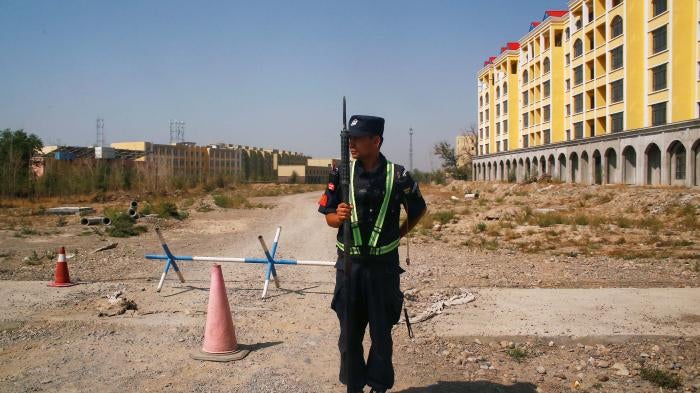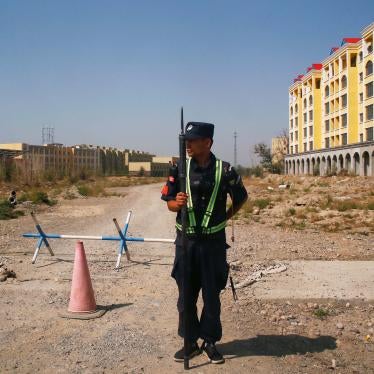摘要
「斷代、斷根、斷聯、斷源一個不漏,徹底把『兩面人』的根子鏟乾淨、挖乾淨,誓與『兩面人』鬥爭到底。」
——買蘇木江・買木爾(Maisumujiang Maimuer),宗教事務官員,2017年8月10日,新華社微博
2014年5月,中國政府在新疆維吾爾自治區針對突厥裔穆斯林發動「嚴厲打擊暴力恐怖活動專項行動」。[1] 史丹福大學法律學院人權與衝突解決診所和人權觀察的研究,以及各人權組織、媒體、維權團體等各方面的報導,顯示中國政府對當地突厥裔穆斯林人口已經實施——且仍在持續實施——危害人類罪行。[2]
本報告為前述結論提出事實基礎,並基於國際法框架對中國政府在新疆作為的可得資訊進行評估。
根據《國際刑事法院羅馬規約》,危害人類罪是指在明知對任何平民人口進行廣泛或有系統攻擊下,作為攻擊的一部分而實施的重大特定罪行。「普遍」意指行為的規模或受害者的人數。「有系統」攻擊是指形成模式或按部就班的計劃。危害人類罪可以在和平時期或者武裝衝突期間實施,只要它是針對平民人口。
危害人類罪被視為國際法上最嚴重的人權侵犯之一。本報告紀錄的具體危害人類罪行包括:違反國際法的監禁或以其他形式剥奪自由;迫害一個可識別的族群或宗教群體;強迫失蹤;酷刑;謀殺;以及疑似故意造成極大痛苦或對身心健康造成嚴重傷害的不人道行為,特別是強迫勞動和性暴力。
新疆維吾爾自治區位於中國西北部,是中國唯一以穆斯林人口佔多數的地區。該地區包括維吾爾族、哈薩克族、柯爾克孜族及其他多個民族均屬突厥裔族群。和中國多數民族即主要說中文的漢族不同,突厥裔人口多為穆斯林並有自己的母語。根據2010年人口普查,維吾爾族約佔新疆人口的百分之46,哈薩克族約佔百分之7。
中國政府對突厥裔穆斯林的鎮壓並不是新的現象,但在最近幾年達到前所未見的程度。高達一百萬人被任意拘禁在300到400間設施[3] ),包括「政治教育」營、看守所和監獄。[4] 法院未經正當程序即判下重刑,突厥裔穆斯林僅因向家屬寄送伊斯蘭宗教影音或下載維吾爾文電子書就被判處數年監禁。在押人員和囚犯受到酷刑和其他虐待、文化和政治思想灌輸以及強迫勞動。這些鎮壓直到離開拘禁設施仍在持續:中國當局對突厥裔穆斯林施加廣泛的大規模監控系統、限制遷徙、任意逮捕和強迫失蹤、抹殺其文化與宗教、以及拆散家庭。
美國國務院和比利時、加拿大及荷蘭國會皆已認定中國的行為亦構成國際法上的種族滅絕。人權觀察目前尚未紀錄到種族滅絕蓄意要件的存在。不過,本報告內容並不排除這種結論,而且,若有相關證據出現,目前針對新疆突厥裔穆斯林——作為受到1948年種族滅絕罪公約保護的一個群體——所實施的各種行為也可能支持種族滅絕的結論。
2017年,根據官方統計,新疆逮捕人數幾乎佔到全中國逮捕人數近百分之21,儘管新疆居民僅佔全國人口的百分之1.5。從2017年起,中國當局利用各種不同理由損壞或摧毀了新疆三分之二的清真寺;其中近半遭徹底推平。全區主要的伊斯蘭教聖地都被剷除。[5] 自治區當局以「結親」名義實施侵入性的監控、發展與思想灌輸計劃,派遣官員幹部到突厥裔穆斯林的家中留宿,美其名為「促進民族團結」。另一種駭人措施是,有些突厥裔穆斯林兒童因父母遭任意拘禁而被安置到孤兒院或寄宿學校、寄宿幼兒園等官方設施。[6]
這種種侵犯人權的舉措已日益招致全球質疑。有些政府,如加拿大、歐盟、英國和美國,已經對中國政府官員與涉及侵犯人權的企業實施針對性或其他類型的制裁。越來越多國家加入在聯合國人權理事會和聯合國大會第三委員會(負責人權事務)發表的聲明,譴責中國政府相關政策。然而,仍有許多國家對中國政府的新疆政策表示讚揚,包括伊斯蘭合作組織的部分成員。
2019年7月,24個國家聯名致函人權理事會主席,要求讓聯合國人權事務高級專員對新疆人權進行「有效視察」,監測並報告當地疑似侵犯穆斯林人口的行為。[7] 中國政府的反應是組織其他50個國家(不包括中國本身)發表聯名信,簽署者包括伊朗、北韓、沙特阿拉伯、委內瑞拉等人權紀錄惡劣的國家。[8] 2019年11月,同一群國家又向聯大第三委員會遞交一份譴責聲明。中國政府再次以54國聯名信回應。[9]
2020全年,有關新疆人權侵犯的報導持續增加,使各國政府更難否認或忽視。2020年6月,50個聯合國特別程序——包括特別報告員、工作組和其他人權專家——對中國人權紀錄發出強烈指控,包括中國政府對新疆、西藏的宗教和少數民族進行「集體鎮壓」。專家們呼籲人權理事會就中國問題召開特別會議,成立專責監測中國的聯合國機制,並要求聯合國機構與各國政府施壓中國履行人權義務。[10] 2020年10月,跨區域集團的39個國家發表公開聲明,尖銳抨擊中國政府在新疆、香港和西藏的普遍人權侵害。該聲明大體上支持前述聯合國50個特別程序的呼籲。[11] 中國政府沒有對相關指控進行調查,僅以兩份聲明回應,其中一份關於新疆的聲明由古巴宣讀,並有45國聯署。[12]
調查中國危害人類罪
在發生嚴重人權侵害區域享有管轄權的國家,有義務確保相關罪行受到司法追究。該等國家有義務確保國內刑事司法機制就疑似人權侵害實施公正調查,並依據國際公正審判標準查明並起訴責任人。中國政府一再否認有官員在新疆涉及侵犯人權,既不願自行調查也不允許獨立的國際監察員實地調查。
歷史上,未對嚴重人權侵犯進行調查的政府往往援引國家主權,拒絕其他有關當局如聯合國機構或區域性國際組織前往調查。根據2002年生效的《國際刑事法院羅馬規約》,若享有主要管轄權的國家缺乏意願或能力,該法院即有權對疑涉危害人類罪及其他重大國際罪行的主要責任人進行調查和起訴。若涉嫌加害人是國際刑事法院締約國的公民,若相關罪行發生在國際刑事法院成員國的領土,或若有非成員國請求國際刑事法院審查在其領土內發生的罪行,國際刑事法院便可實施調查與起訴。中國並非國際刑事法院成員國。雖然國際刑事法院可以在聯合國安全理事會將新疆情勢移交該法院時取得管轄權,但中國作為安理會常任理事國可以動用否決權阻止移交。
鑒於突厥裔穆斯林所受的迫害如此嚴重,有關各國迫切需要採取強硬、一致的問責行動。辦法之一是由聯合國成立調查委員會,對新疆人權侵犯的指控進行調查。調查委員會職權應包括認定事實、查明加害人和提出問責建議。委員會應由知名人士組成,包括國際人權法、危害人類罪、少數族群與宗敎權利以及性別議題等專家。委員會可以通過聯合國人權理事會的決議成立,但聯合國大會、聯合國安理會和聯合國秘書長也都有權採取相關行動。
本報告也對各有關國家提出其他建議,以便加強施壓中國政府,改變其侵犯人權的新疆政策,包括追究相關罪行的個人刑責與國家責任、針對性制裁、以及根據其他聯合國機制如《消除一切形式種族歧視國際公約》採取行動。
個別國家應當考慮刑事追訴——根據「普遍管轄權」(universal jurisdiction)概念,各國可以利用國內司法系統調查和起訴諸如酷刑等特定重大犯罪,即使犯罪地點不屬該國領土。許多國家都已立法允許對被害人為本國國民的這類罪行加以起訴。各種人權條約,例如《反酷刑公約》和《反強迫失蹤國際公約》,都要求締約國引渡或起訴在其境內的嫌疑犯。根據國際習慣法,各國基本上可以對危害人類罪的嫌犯進行起訴。
建議
對中國政府
-
立即採取措施,終止對新疆和其他地區突厥裔穆斯林的人權侵害,特別是:任意拘押和監禁,包括所謂的「再教育」營;酷刑和其他虐待;限制宗教自由、隱私與遷徙;性暴力和強迫絕育;以及強迫勞動。
-
立即採取措施,終止對突厥裔穆斯林的疑涉危害人類罪行。
-
調查並適當起訴涉嫌嚴重侵犯人權和危害人類罪的政府官員。
對聯合國
-
聯合國人權理事會應通過決議成立調查委員會,並授予下列權限:
-
調查以新疆突厥裔穆斯林為目標的疑涉危害人類罪和其他人權侵害行為,包括:非法監禁或其他形式嚴重剥奪人身自由;基於政治、種族、民族、族群、文化或宗教理由迫害某個可識別團體;強迫失蹤;酷刑;謀殺;其他不人道行為,包括強迫勞動;限制宗教自由;性暴力;以及侵犯生育權利;
-
作出終止相關侵犯行為的建議;
-
指出負責官員並提出將其繩之以法的具體途徑;
-
呼籲給予受害者和倖存者適當賠償;以及
-
定期向理事會和聯合國其他相關機構提交報告。
-
-
聯合國人權事務高級專員應履行其獨立監察和報告的職權,收集相關資訊,就其結論發表公開抗議,為新疆人權情勢撰寫報告,並定期向人權理事會提供更新資訊。
-
聯合國各種特別程序應就其職權對中國當局在新疆侵犯人權進行持續紀錄和公開報導,據以支持設立調查委員會或類似的調查機制。
-
聯合國秘書長應公開支持對新疆人權侵犯成立調查委員會,並在公開和私下敦促中國當局終止對新疆突厥裔穆斯林的迫害。秘書長應公開支持對發生在新疆的危害人類罪行追究責任。
-
聯合國大會應要求負責調查新疆人權侵犯的委員會也向大會提交報告,並將相關報告轉交給所有聯合國成員國和聯合國有關機構。
-
大會應通過決議,公開支持具體問責措施,包括對危害人類罪的責任人實施針對性制裁。
-
聯合國安全理事會成員國應在中國作為常任理事國的條件下採取最大可能的行動,包括通過阿里亞辦法(Arria Formula)會議或其他途徑,對於成立委員會調查新疆人權侵害表達支持。
對有關各國政府
協調一致的雙邊或多邊行動
-
依據美國《全球馬格尼茨基法》和類似的政府間或國內法律工具,實施簽證禁令、旅遊禁令和針對性個別制裁;這種制裁若以集體方式實施將更有成效。
-
在所有譴責新疆人權侵犯的個別或聯合聲明中,指出中國當局應為犯罪行為負責,這些行為是針對新疆突厥裔穆斯林的普遍且有系統攻擊的一部分,構成危害人類罪。
-
基於普遍管轄權的法律基礎,協助起訴涉及危害人類罪的中國官員。
-
鼓勵本國檢察官發動框架性調查,即類似國際刑事法院的初步審查,由檢察機關針對疑涉嚴重違法行為收集並分析有關資訊,為將來起訴奠定基礎。
-
對既經證實協助中國在新疆執行大規模監控的科技業者實施更強硬行動,包括引用《全球馬格尼茨基法》和類似的制裁措施。
-
《消除一切形式種族歧視國際公約》締約各國應就中國對突厥裔穆斯林的違反公約行為提出個別或聯合控訴。
關於貿易、投資和商業活動
-
有關政府機構應審查所有對新疆的投資,並在必要時針對據可靠指控涉及嚴重侵害(例如強迫勞動)的產業部門實施貿易制裁,包括撤資。
-
向企業發出類似加拿大於2021年1月針對下列議題所做的公開建議:
-
新疆人權侵害的嚴重性,包括強迫勞動;
-
企業依據國際法和國內法應負的法律責任;
-
因直接商業活動和供應鏈成為人權侵害共犯的風險;以及
-
對於在中國一切商業交易應進行透明及徹底人權盡職調查的責任。
-
-
在有關強迫勞動的舉報得到獨立且公正的國際專家調查、侵害得到解決、加害者受到追究且受害者得到賠償之前,歐盟不應將《歐中投資協定》送交歐洲議會通過。
-
呼籲工商業者公開發布在新疆開展業務對象的名稱、地址、所有權及其他相關詳情。
-
立法規定在新疆運營企業必須執行人權盡職調查。
-
檢討國際金融機構的投資組合,確保其不致參與該地區的迫害行為。
對境內有突厥裔流亡社群的各國
-
確保突厥裔穆斯林申請庇護能夠得到公正制度的裁決。
-
允許突厥裔穆斯林的家屬入境團聚,以協助家庭團聚。
-
終止一切遣返措施及其他形式直接或間接強迫突厥裔穆斯林返回中國。
-
建立機制以追踪發生在其他國家的騷擾突厥裔穆斯林案件,並採取包括刑事司法在內的措施以追究加害者責任。
-
確保突厥裔穆斯林能夠獲得為酷刑、強暴和其他犯罪被害人提供的法律、醫療和心理援助,以及文化與宗教保存方案。
對企業和投資者
- 認識到目前在新疆因為政府干預已不可能履行聯合國《工商企業與人權指導原則》要求承擔的人權盡職調查責任。
- 加入為終止涉及突厥裔穆斯林強迫勞動做法的「行動呼籲」,或採取類似措施。

